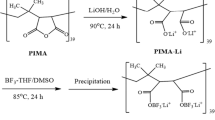Abstract
Solid polymer electrolytes are still collecting attention today for development of safer Li-ion batteries. Introduction of boron moieties to electrolytes generally improves ion conductive properties of resultant electrolytes. Herein, we have undertaken dehydrocoupling reaction between glycerol (Gly)/triethylene glycol (TEG) and hydroborane to synthesize highly branched organoboron polymer electrolytes. Increase in amorphous nature of polymer due to branched structure improved the ionic conduction. This was supported from decreased Vogel–Fulcher–Tammann parameters corresponding to activation energy of ion transport in matrices. When Gly content was increased beyond [Gly]/[TEG] = 15%, ionic conductivity decreased due to decrease in solubility of the salt in organoboron polymer matrix.




Similar content being viewed by others
References
Scrosati B, Garche J (2010) Lithium batteries: status, prospects and future. J Power Sources 195:2419–2430
Stephan AM (2006) Review on gel polymer electrolytes for lithium batteries. Eur Polymr J 42:21–42
Wright PV (1976) Anomalous transition to a lower activation-energy for dc electrical-conduction above glass-transition temperature. J Polym Sci Part B 14:955
Tarascon JM, Armand M (2001) Issues and challenges facing rechargeable lithium batteries. Nature 414:359–367
Mehta MA, Fujinami T (1997) Li+ transference number enhancement in polymer electrolytes by incorporation of anion trapping boroxine rings into the polymer host. Chem Lett 26:915–916
Sun XG, Angell CA (2001) “Acid-in-chain” versus “base-in-chain” anionic polymer electrolytes for electrochemical devices. Electrochim Acta 46:1467–1473
Hirakimoto T, Nishiura M, Watanabe M (2001) Effects of addition of a boric acid ester monomer to electrolyte solutions and gel electrolytes on their ionic transport properties. Electrochim Acta 46:1609–1614
Matsumi N, Sugai K, Ohno H (2002) Selective ion transport in organoboron polymer electrolytes bearing a mesitylboron unit. Macromolecules 35:5731–5733
Matsumi N, Sugai K, Ohno H (2003) Ion conductive characteristics of alkylborane type and boric ester type polymer electrolytes derived from mesitylborane. Macromolecules 36:2321–2326
Nishihara Y, Miyazaki M, Tomita Y, Kadono Y, Takagi K (2008) Synthesis and ion conductive characteristics of inorganic-organic hybrid polymers bearing a tetraarylpentaborate unit. J Polym Sci Part A Polym Chem 46:7913–7918
Chujo Y, Tomita I, Hashiguchi Y, Tanigawa H, Ihara E, Saegusa T (1991) Hydroboration polymerization. 1. Synthesis of organoboron polymer by polyaddition between diene and monoalkylborane. Macromolecules 24:345–348
Matsumi N, Chujo Y (2008) π-Conjugated organoboron polymers via the vacant p-orbital of the boron atom. Polym J 40:77–89
Matsumi N, Naka K, Chujo Y (1998) Extension of π-conjugation length via the vacant p-orbital of the boron atom. Synthesis of novel electron deficient π-conjugated systems by hydroboration polymerization and their blue light emission. J Am Chem Soc 120:5112–5113
Matsumi N, Chujo Y (1997) Synthesis of novel organoboron polymers by hydroboration polymerization of bisallene compounds. Polym Bull 38:531–536
Miyata M, Matsumi N, Chujo Y (2001) Synthesis of poly(cyclodiborazane)s by hydroboration polymerization of dicyanooligothiophenes and their light-emitting properties. Macromolecules 34:7331–7335
Matsumi N, Naka K, Chujo Y (1998) Hydroboration polymerization of dicyanoanthracene using mesitylborane. Macromolecules 31:8047–8050
Chujo Y, Tomita I, Saegusa T (1991) Boronate oligomers via dehydrogenation of diols with thexylborane. Polym J 23:743–746
Allcock HR, OConnor SJM, Olmeijer DL, Napierala ME, Cameron CG (1996) Polyphosphazenes bearing branched and linear oligoethyleneoxy side groups as solid solvents for ionic conduction. Macromolecules 29:7544–7552
Hooper R, Lyons LJ, Moline DA, West R (1999) A highly conductive solid-state polymer electrolyte based on double-comb polysiloxane polymer with oligo(ethylene oxide) side chains. Organometallics 18:3249–3251
Vogel H (1921) The temperature dependence law of the viscosity of fluids. Phys Z 22:645–646
Fulcher GS (1925) Analysis of recent measurements of the viscosity of glasses. J Am Ceram Soc 8:339
Tamman G, Hesse W (1926) Die abhängigkeit der viskosität von der temperature bei unterkühlten flüssigkeiten. Z Anorg Allg Chem 156:245–257
Acknowledgments
Authors are grateful to New Energy and Industrial Technology Development Organization of Japan (NEDO; project ID 09B33004a) for financial grant for this project.
Author information
Authors and Affiliations
Corresponding author
Rights and permissions
About this article
Cite this article
Shankar, S.R., Matsumi, N. Hyperbranched organoboron polymer electrolytes derived from glycerol. Polym. Bull. 68, 721–727 (2012). https://doi.org/10.1007/s00289-011-0575-z
Received:
Revised:
Accepted:
Published:
Issue Date:
DOI: https://doi.org/10.1007/s00289-011-0575-z




